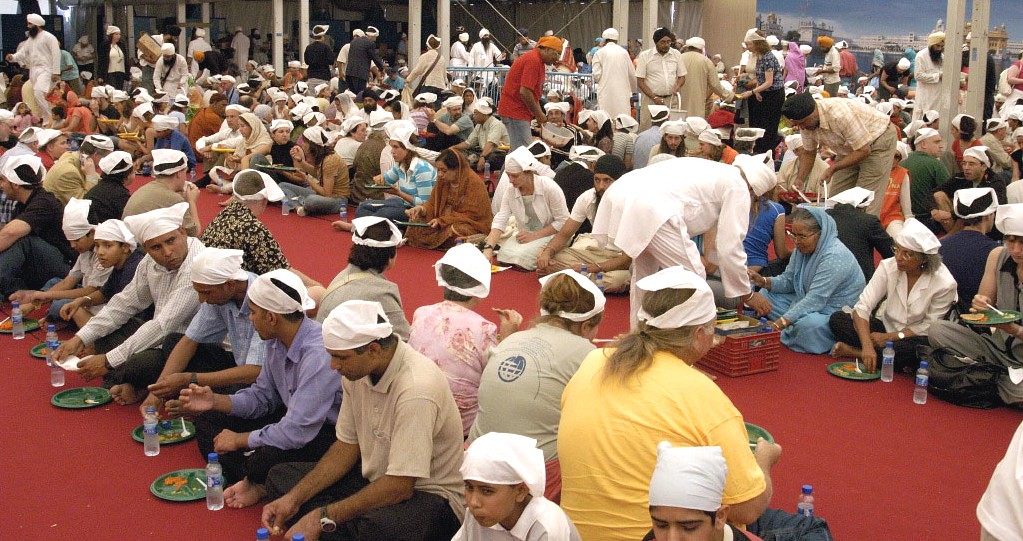Sikh Langar

Credit: Hari Singh
Licence: Creative Commons BY-SA 3.0
| Giver: | Community |
|---|---|
| Receiver: | Individual or unstructured/informal group |
| Gift: | Items |
| Approach: | Other |
| Issues: | 2. Zero Hunger |
| Included in: | Food and Generosity, Religious Giving |
Langar, the practice of preparing and serving a free communal meal for all those who want it, is a cornerstone of Sikhism, an Indian religion defined by its emphasis on kindness and generosity. Langar reflects the Sikh commitment to seva (selfless service), a form of giving with no expectation of reciprocity or reward. Every gurdwara (Sikh place of worship) has a langar kitchen and dining area run entirely by volunteers known as sevadars. By welcoming people of all races, religions and social strata to sit together for a nourishing meal, langar promotes Sikh principles of hospitality, inclusiveness and universal equality.
Langar a Persian word meaning almshouse has been traced to Baba Farid, a 13th century Punjabi Muslim saint who used his Khanqah (monastery) to distribute food among local people. This practice soon spread to other Khanqahs across the region.
When Guru Nanak founded Sikhism in the Punjab region of the Indian subcontinent in the late 15th century, he adopted the practice of langar to ritualize the practice of giving at the core of his religious philosophy. Nanak also embraced langar to illustrate Sikhism’s fundamental belief in the equality of all people. Although he was born to a family of high social caste, from an early age he rejected the notion of hereditary hierarchy that underpinned India’s caste system.
In Nanak’s time, it was taboo for members of different castes to eat together, or even use the same pots. Food preparation and consumption were strictly segregated to avoid the food of a higher caste becoming polluted by contact with a lower caste. In this context, the non-discriminatory, communal tenets of Nanak’s langar offered a radical alternative to the social norm.
Today, Sikhism is the fifth-largest organized religion in the world, with at least 25 million adherents globally. Wherever Sikhs congregate, from the most modest gurdwara to the most opulent, they offer the langar _meal, welcoming not only Sikh congregants but also visitors of all backgrounds and identities. Attendees – men and women, old and young, people of privilege and those experiencing hunger and material poverty -- sit on the floor as equals. Together they form an unbroken line known as the _pangat, which symbolizes universal belonging to a common family. Everyone eats the same vegetarian meal from the same pots, prepared and served by a diverse group of sevadars.
The most prodigious demonstration of Sikh generosity through seva occurs at the Golden Temple in Amritsar, India, the spiritual center of Sikhism. There, hundreds of sevadars _continuously provide the _langar meal, serving a traditional meal of lentils, rice, vegetables and roti (bread) to 100,000 people per day, seven days a week. As visitors from all over the world form the pangat -- seated on the floor, shoulder to shoulder – and partake of this humble meal, the Sikh vision of human generosity and equality achieves one of its most powerful expressions.
Contributor: Erin Brown
| Source type | Full citation | Link (DOI or URL) |
|---|---|---|
| Publication |
Chaudhary, Srishti and Raphael Reichel. “Amritsar: The Indian City where No One Goes Hungry.” BBC, June 13, 2023. |
https://www.bbc.com/travel/article/20230612-amritsar-the-indian-city-where-no-one-goes-hungry |
| Publication |
Krishna, Priya. “How to Feed Crowds in a Protest or Pandemic? The Sikhs Know.” The New York Times, June 8, 2020. |
https://nytimes.com/2020/06/08/dining/free-food-sikh-gundwara-langar.html |
| Publication |
Singh, Indarjit. “Traditions of Giving in Sikhism.” Alliance Magazine, June 1, 2001. |
https://www.alliancemagazine.org/analysis/traditions-of-giving-in-sikhism/ |
| Publication |
Singh, Sarbpreet. “Guru Nanak’s Langar and Legacy: Tracing the Origin of the Practice, What It Says about His Commitment to Inclusion.” Firstpost, November 14, 2019. |
https://www.firstpost.com/living/guru-nanaks-langar-and-legacy-tracing-the-origin-of-the-practice-what-it-says-about-his-commitment-to-inclusion-7605211.html |